Influence of Factors on Consumer Behaviour and Attitude in Hospitality
VerifiedAdded on 2023/01/19
|11
|2345
|20
AI Summary
This report explores the influence of various factors on consumer behaviour and attitude in the hospitality industry. It covers topics such as changes in consumer trends due to digital technology, stages of consumer decision making, and the significance for marketers to map a path of purchase and consumer decision making.
Contribute Materials
Your contribution can guide someone’s learning journey. Share your
documents today.
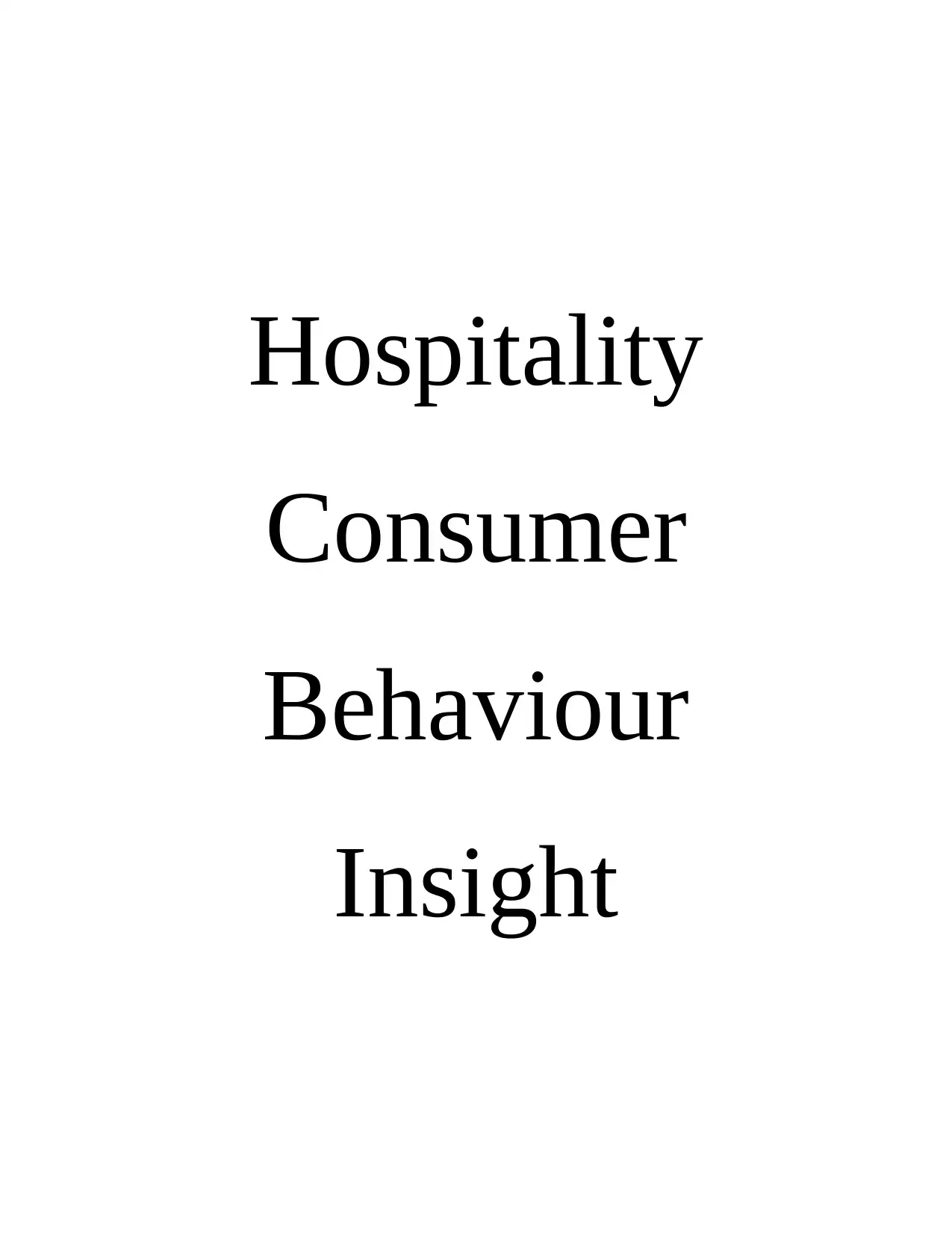
Hospitality
Consumer
Behaviour
Insight
Consumer
Behaviour
Insight
Secure Best Marks with AI Grader
Need help grading? Try our AI Grader for instant feedback on your assignments.
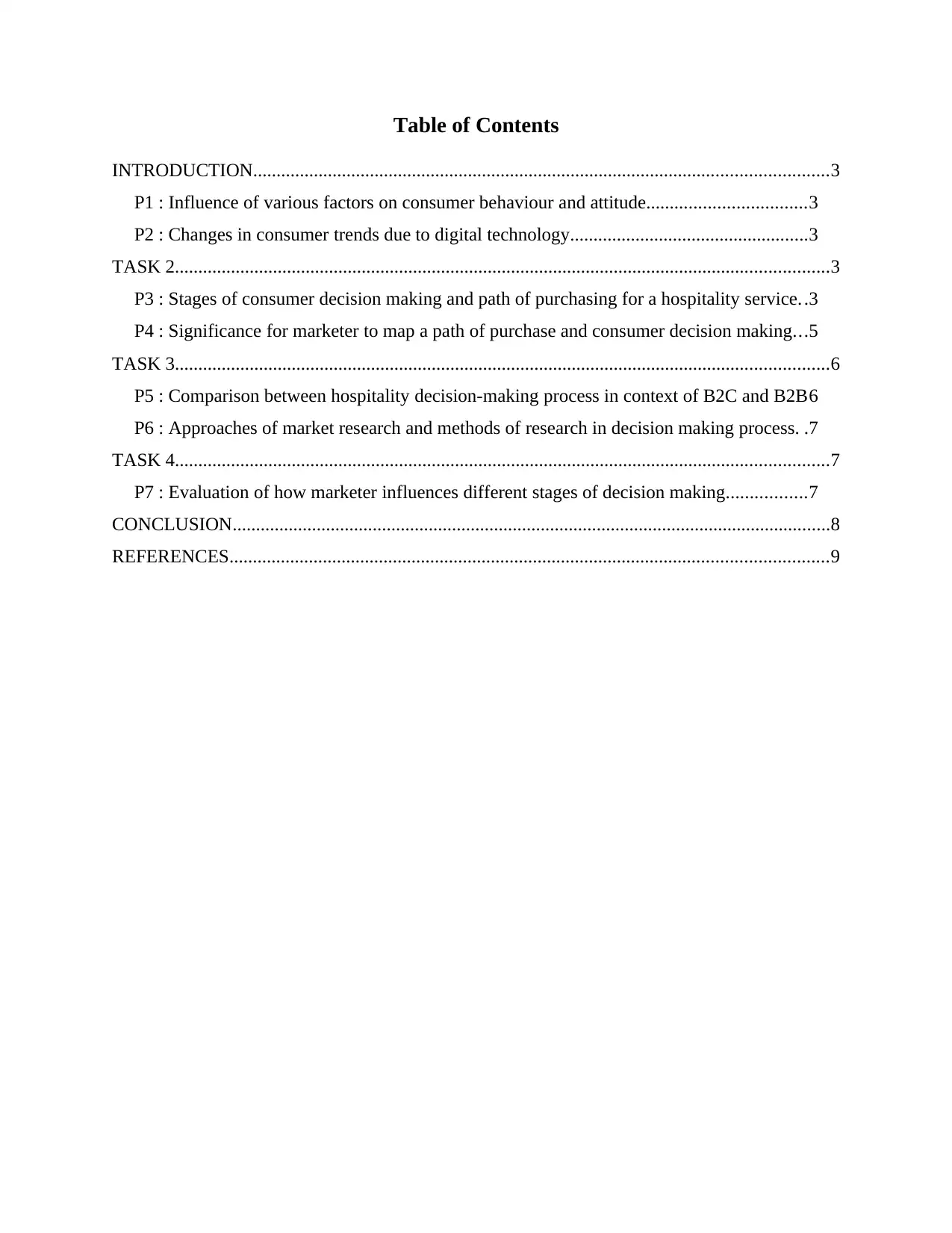
Table of Contents
INTRODUCTION...........................................................................................................................3
P1 : Influence of various factors on consumer behaviour and attitude..................................3
P2 : Changes in consumer trends due to digital technology...................................................3
TASK 2............................................................................................................................................3
P3 : Stages of consumer decision making and path of purchasing for a hospitality service..3
P4 : Significance for marketer to map a path of purchase and consumer decision making...5
TASK 3............................................................................................................................................6
P5 : Comparison between hospitality decision-making process in context of B2C and B2B6
P6 : Approaches of market research and methods of research in decision making process. .7
TASK 4............................................................................................................................................7
P7 : Evaluation of how marketer influences different stages of decision making.................7
CONCLUSION................................................................................................................................8
REFERENCES................................................................................................................................9
INTRODUCTION...........................................................................................................................3
P1 : Influence of various factors on consumer behaviour and attitude..................................3
P2 : Changes in consumer trends due to digital technology...................................................3
TASK 2............................................................................................................................................3
P3 : Stages of consumer decision making and path of purchasing for a hospitality service..3
P4 : Significance for marketer to map a path of purchase and consumer decision making...5
TASK 3............................................................................................................................................6
P5 : Comparison between hospitality decision-making process in context of B2C and B2B6
P6 : Approaches of market research and methods of research in decision making process. .7
TASK 4............................................................................................................................................7
P7 : Evaluation of how marketer influences different stages of decision making.................7
CONCLUSION................................................................................................................................8
REFERENCES................................................................................................................................9
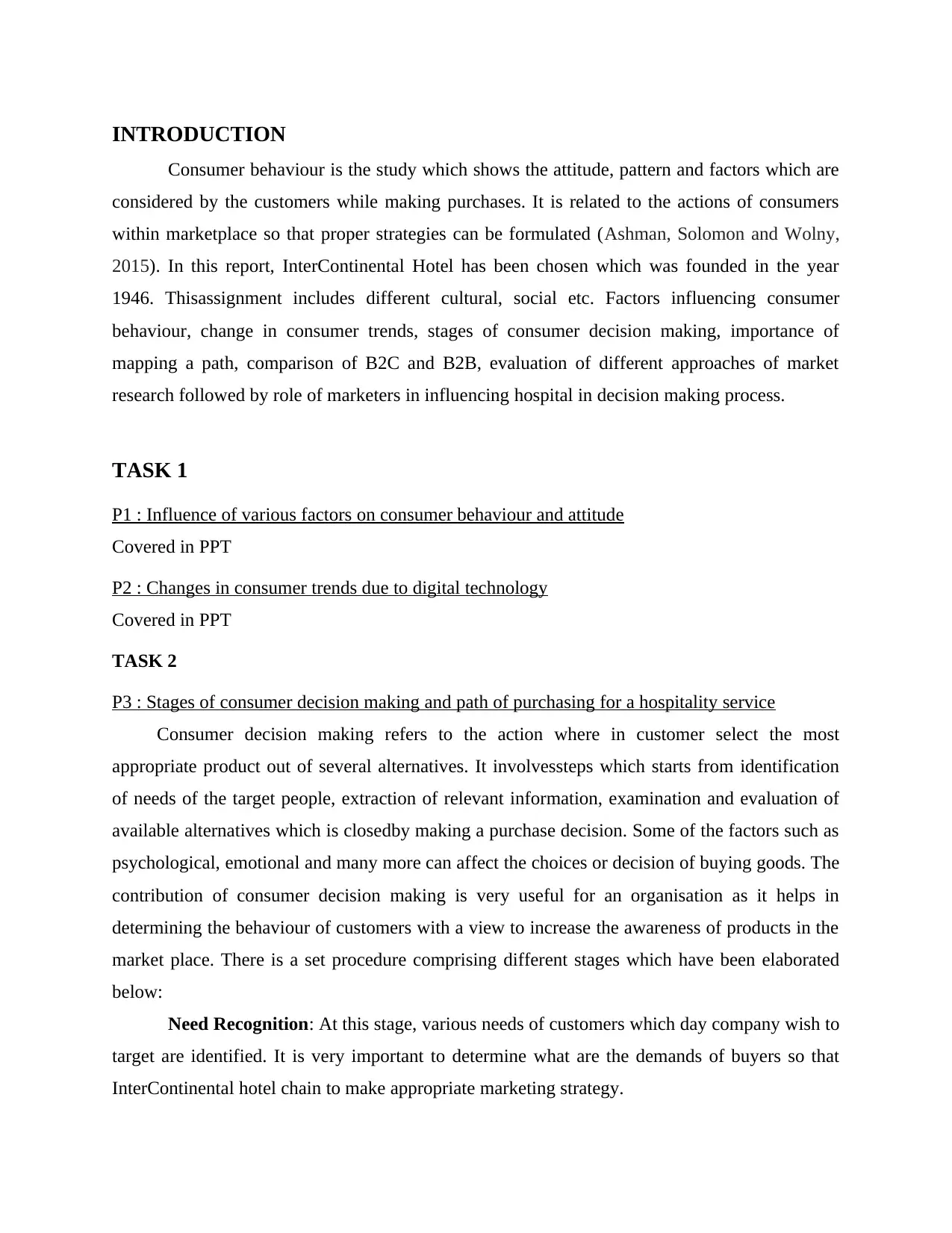
INTRODUCTION
Consumer behaviour is the study which shows the attitude, pattern and factors which are
considered by the customers while making purchases. It is related to the actions of consumers
within marketplace so that proper strategies can be formulated (Ashman, Solomon and Wolny,
2015). In this report, InterContinental Hotel has been chosen which was founded in the year
1946. Thisassignment includes different cultural, social etc. Factors influencing consumer
behaviour, change in consumer trends, stages of consumer decision making, importance of
mapping a path, comparison of B2C and B2B, evaluation of different approaches of market
research followed by role of marketers in influencing hospital in decision making process.
TASK 1
P1 : Influence of various factors on consumer behaviour and attitude
Covered in PPT
P2 : Changes in consumer trends due to digital technology
Covered in PPT
TASK 2
P3 : Stages of consumer decision making and path of purchasing for a hospitality service
Consumer decision making refers to the action where in customer select the most
appropriate product out of several alternatives. It involvessteps which starts from identification
of needs of the target people, extraction of relevant information, examination and evaluation of
available alternatives which is closedby making a purchase decision. Some of the factors such as
psychological, emotional and many more can affect the choices or decision of buying goods. The
contribution of consumer decision making is very useful for an organisation as it helps in
determining the behaviour of customers with a view to increase the awareness of products in the
market place. There is a set procedure comprising different stages which have been elaborated
below:
Need Recognition: At this stage, various needs of customers which day company wish to
target are identified. It is very important to determine what are the demands of buyers so that
InterContinental hotel chain to make appropriate marketing strategy.
Consumer behaviour is the study which shows the attitude, pattern and factors which are
considered by the customers while making purchases. It is related to the actions of consumers
within marketplace so that proper strategies can be formulated (Ashman, Solomon and Wolny,
2015). In this report, InterContinental Hotel has been chosen which was founded in the year
1946. Thisassignment includes different cultural, social etc. Factors influencing consumer
behaviour, change in consumer trends, stages of consumer decision making, importance of
mapping a path, comparison of B2C and B2B, evaluation of different approaches of market
research followed by role of marketers in influencing hospital in decision making process.
TASK 1
P1 : Influence of various factors on consumer behaviour and attitude
Covered in PPT
P2 : Changes in consumer trends due to digital technology
Covered in PPT
TASK 2
P3 : Stages of consumer decision making and path of purchasing for a hospitality service
Consumer decision making refers to the action where in customer select the most
appropriate product out of several alternatives. It involvessteps which starts from identification
of needs of the target people, extraction of relevant information, examination and evaluation of
available alternatives which is closedby making a purchase decision. Some of the factors such as
psychological, emotional and many more can affect the choices or decision of buying goods. The
contribution of consumer decision making is very useful for an organisation as it helps in
determining the behaviour of customers with a view to increase the awareness of products in the
market place. There is a set procedure comprising different stages which have been elaborated
below:
Need Recognition: At this stage, various needs of customers which day company wish to
target are identified. It is very important to determine what are the demands of buyers so that
InterContinental hotel chain to make appropriate marketing strategy.
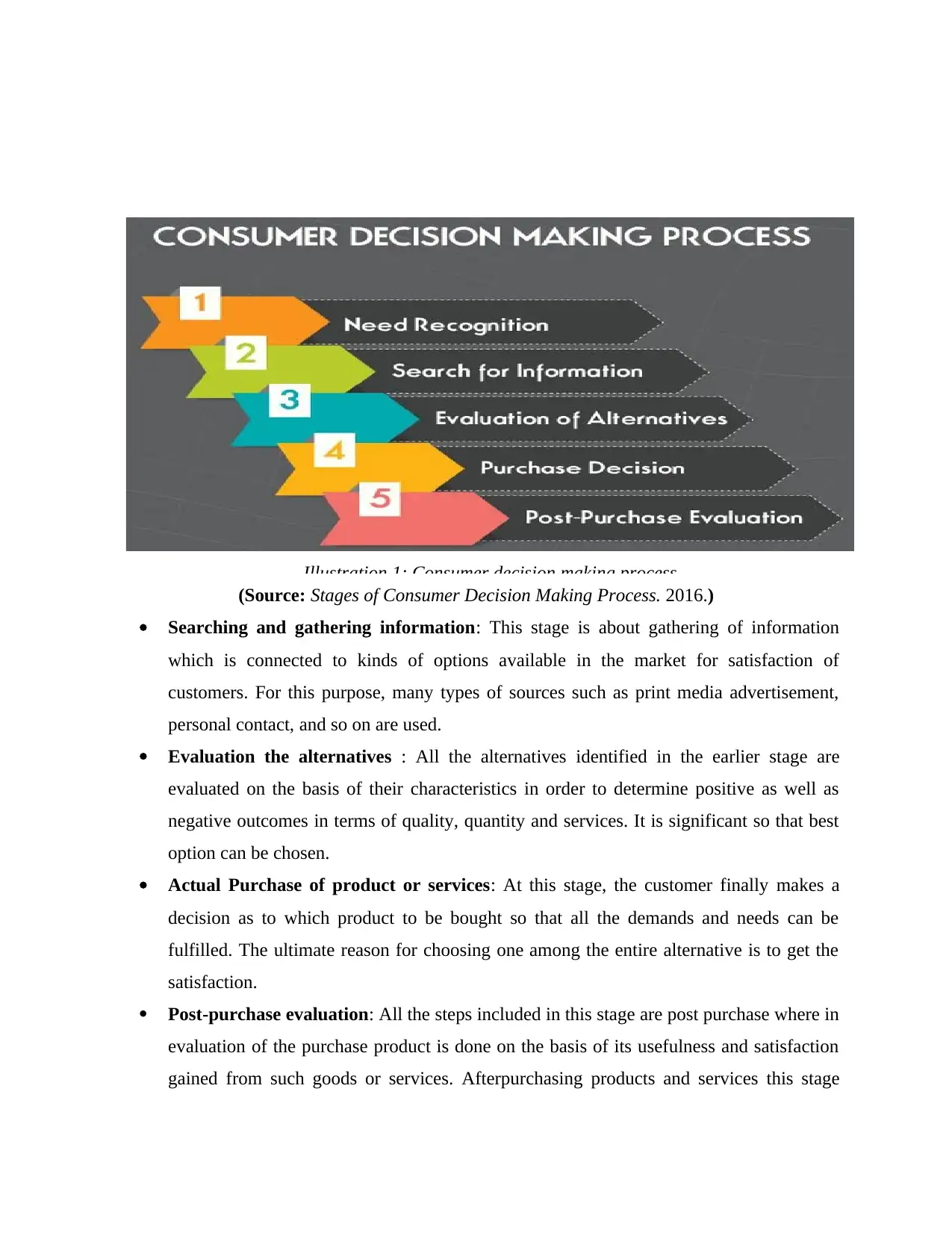
Illustration 1: Consumer decision making process
(Source: Stages of Consumer Decision Making Process. 2016.)
Searching and gathering information: This stage is about gathering of information
which is connected to kinds of options available in the market for satisfaction of
customers. For this purpose, many types of sources such as print media advertisement,
personal contact, and so on are used.
Evaluation the alternatives : All the alternatives identified in the earlier stage are
evaluated on the basis of their characteristics in order to determine positive as well as
negative outcomes in terms of quality, quantity and services. It is significant so that best
option can be chosen.
Actual Purchase of product or services: At this stage, the customer finally makes a
decision as to which product to be bought so that all the demands and needs can be
fulfilled. The ultimate reason for choosing one among the entire alternative is to get the
satisfaction.
Post-purchase evaluation: All the steps included in this stage are post purchase where in
evaluation of the purchase product is done on the basis of its usefulness and satisfaction
gained from such goods or services. Afterpurchasing products and services this stage
(Source: Stages of Consumer Decision Making Process. 2016.)
Searching and gathering information: This stage is about gathering of information
which is connected to kinds of options available in the market for satisfaction of
customers. For this purpose, many types of sources such as print media advertisement,
personal contact, and so on are used.
Evaluation the alternatives : All the alternatives identified in the earlier stage are
evaluated on the basis of their characteristics in order to determine positive as well as
negative outcomes in terms of quality, quantity and services. It is significant so that best
option can be chosen.
Actual Purchase of product or services: At this stage, the customer finally makes a
decision as to which product to be bought so that all the demands and needs can be
fulfilled. The ultimate reason for choosing one among the entire alternative is to get the
satisfaction.
Post-purchase evaluation: All the steps included in this stage are post purchase where in
evaluation of the purchase product is done on the basis of its usefulness and satisfaction
gained from such goods or services. Afterpurchasing products and services this stage
Secure Best Marks with AI Grader
Need help grading? Try our AI Grader for instant feedback on your assignments.
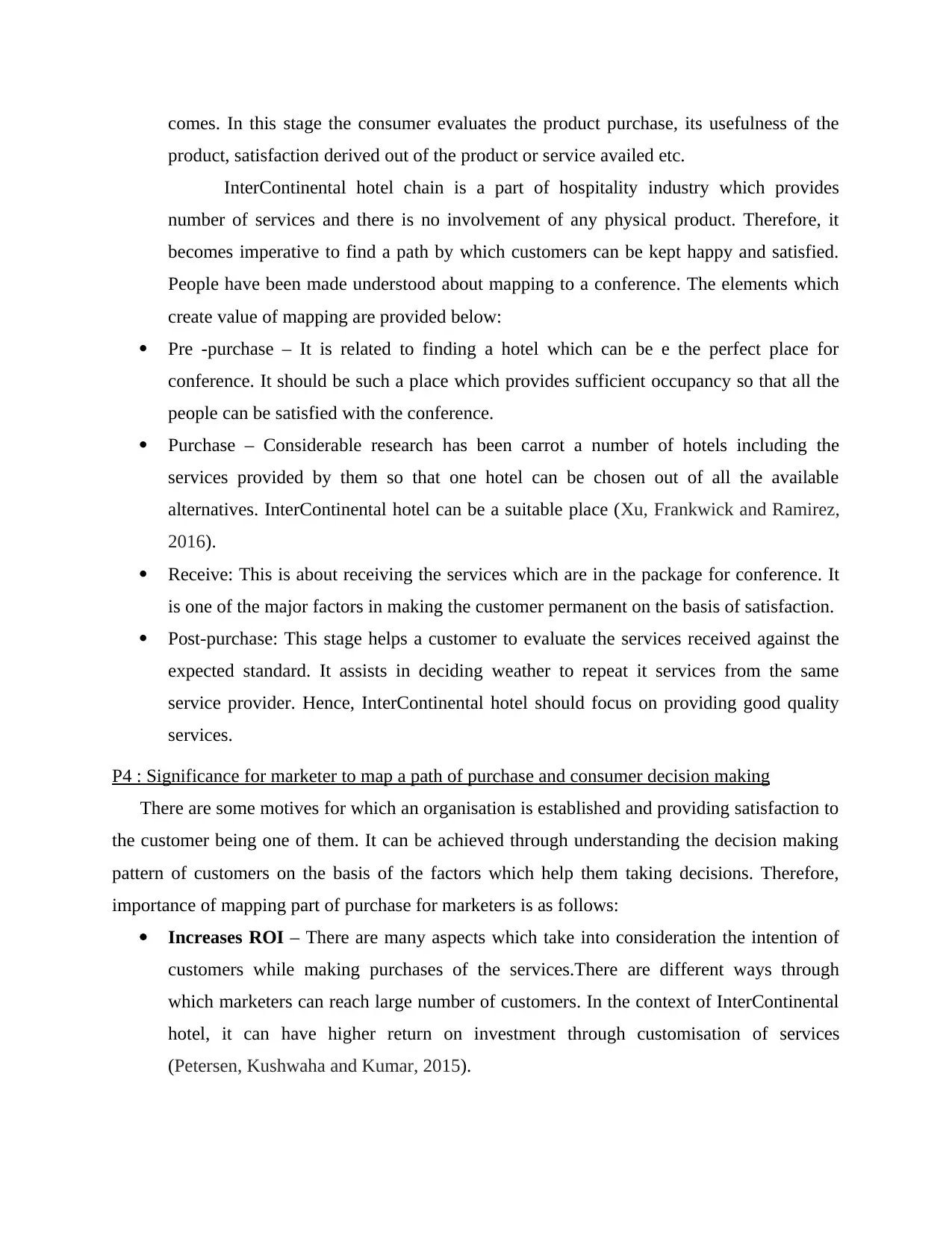
comes. In this stage the consumer evaluates the product purchase, its usefulness of the
product, satisfaction derived out of the product or service availed etc.
InterContinental hotel chain is a part of hospitality industry which provides
number of services and there is no involvement of any physical product. Therefore, it
becomes imperative to find a path by which customers can be kept happy and satisfied.
People have been made understood about mapping to a conference. The elements which
create value of mapping are provided below:
Pre -purchase – It is related to finding a hotel which can be e the perfect place for
conference. It should be such a place which provides sufficient occupancy so that all the
people can be satisfied with the conference.
Purchase – Considerable research has been carrot a number of hotels including the
services provided by them so that one hotel can be chosen out of all the available
alternatives. InterContinental hotel can be a suitable place (Xu, Frankwick and Ramirez,
2016).
Receive: This is about receiving the services which are in the package for conference. It
is one of the major factors in making the customer permanent on the basis of satisfaction.
Post-purchase: This stage helps a customer to evaluate the services received against the
expected standard. It assists in deciding weather to repeat it services from the same
service provider. Hence, InterContinental hotel should focus on providing good quality
services.
P4 : Significance for marketer to map a path of purchase and consumer decision making
There are some motives for which an organisation is established and providing satisfaction to
the customer being one of them. It can be achieved through understanding the decision making
pattern of customers on the basis of the factors which help them taking decisions. Therefore,
importance of mapping part of purchase for marketers is as follows:
Increases ROI – There are many aspects which take into consideration the intention of
customers while making purchases of the services.There are different ways through
which marketers can reach large number of customers. In the context of InterContinental
hotel, it can have higher return on investment through customisation of services
(Petersen, Kushwaha and Kumar, 2015).
product, satisfaction derived out of the product or service availed etc.
InterContinental hotel chain is a part of hospitality industry which provides
number of services and there is no involvement of any physical product. Therefore, it
becomes imperative to find a path by which customers can be kept happy and satisfied.
People have been made understood about mapping to a conference. The elements which
create value of mapping are provided below:
Pre -purchase – It is related to finding a hotel which can be e the perfect place for
conference. It should be such a place which provides sufficient occupancy so that all the
people can be satisfied with the conference.
Purchase – Considerable research has been carrot a number of hotels including the
services provided by them so that one hotel can be chosen out of all the available
alternatives. InterContinental hotel can be a suitable place (Xu, Frankwick and Ramirez,
2016).
Receive: This is about receiving the services which are in the package for conference. It
is one of the major factors in making the customer permanent on the basis of satisfaction.
Post-purchase: This stage helps a customer to evaluate the services received against the
expected standard. It assists in deciding weather to repeat it services from the same
service provider. Hence, InterContinental hotel should focus on providing good quality
services.
P4 : Significance for marketer to map a path of purchase and consumer decision making
There are some motives for which an organisation is established and providing satisfaction to
the customer being one of them. It can be achieved through understanding the decision making
pattern of customers on the basis of the factors which help them taking decisions. Therefore,
importance of mapping part of purchase for marketers is as follows:
Increases ROI – There are many aspects which take into consideration the intention of
customers while making purchases of the services.There are different ways through
which marketers can reach large number of customers. In the context of InterContinental
hotel, it can have higher return on investment through customisation of services
(Petersen, Kushwaha and Kumar, 2015).
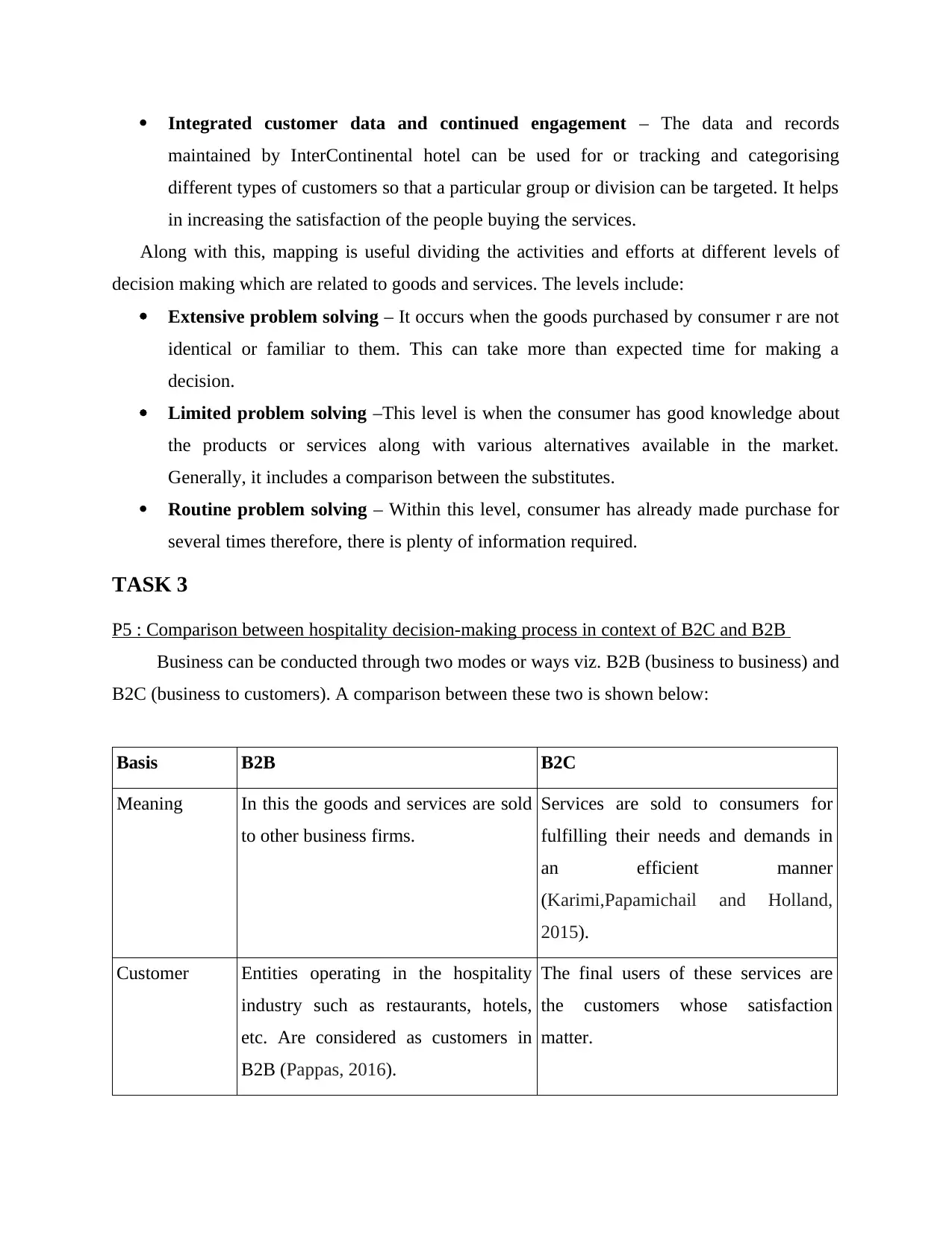
Integrated customer data and continued engagement – The data and records
maintained by InterContinental hotel can be used for or tracking and categorising
different types of customers so that a particular group or division can be targeted. It helps
in increasing the satisfaction of the people buying the services.
Along with this, mapping is useful dividing the activities and efforts at different levels of
decision making which are related to goods and services. The levels include:
Extensive problem solving – It occurs when the goods purchased by consumer r are not
identical or familiar to them. This can take more than expected time for making a
decision.
Limited problem solving –This level is when the consumer has good knowledge about
the products or services along with various alternatives available in the market.
Generally, it includes a comparison between the substitutes.
Routine problem solving – Within this level, consumer has already made purchase for
several times therefore, there is plenty of information required.
TASK 3
P5 : Comparison between hospitality decision-making process in context of B2C and B2B
Business can be conducted through two modes or ways viz. B2B (business to business) and
B2C (business to customers). A comparison between these two is shown below:
Basis B2B B2C
Meaning In this the goods and services are sold
to other business firms.
Services are sold to consumers for
fulfilling their needs and demands in
an efficient manner
(Karimi,Papamichail and Holland,
2015).
Customer Entities operating in the hospitality
industry such as restaurants, hotels,
etc. Are considered as customers in
B2B (Pappas, 2016).
The final users of these services are
the customers whose satisfaction
matter.
maintained by InterContinental hotel can be used for or tracking and categorising
different types of customers so that a particular group or division can be targeted. It helps
in increasing the satisfaction of the people buying the services.
Along with this, mapping is useful dividing the activities and efforts at different levels of
decision making which are related to goods and services. The levels include:
Extensive problem solving – It occurs when the goods purchased by consumer r are not
identical or familiar to them. This can take more than expected time for making a
decision.
Limited problem solving –This level is when the consumer has good knowledge about
the products or services along with various alternatives available in the market.
Generally, it includes a comparison between the substitutes.
Routine problem solving – Within this level, consumer has already made purchase for
several times therefore, there is plenty of information required.
TASK 3
P5 : Comparison between hospitality decision-making process in context of B2C and B2B
Business can be conducted through two modes or ways viz. B2B (business to business) and
B2C (business to customers). A comparison between these two is shown below:
Basis B2B B2C
Meaning In this the goods and services are sold
to other business firms.
Services are sold to consumers for
fulfilling their needs and demands in
an efficient manner
(Karimi,Papamichail and Holland,
2015).
Customer Entities operating in the hospitality
industry such as restaurants, hotels,
etc. Are considered as customers in
B2B (Pappas, 2016).
The final users of these services are
the customers whose satisfaction
matter.
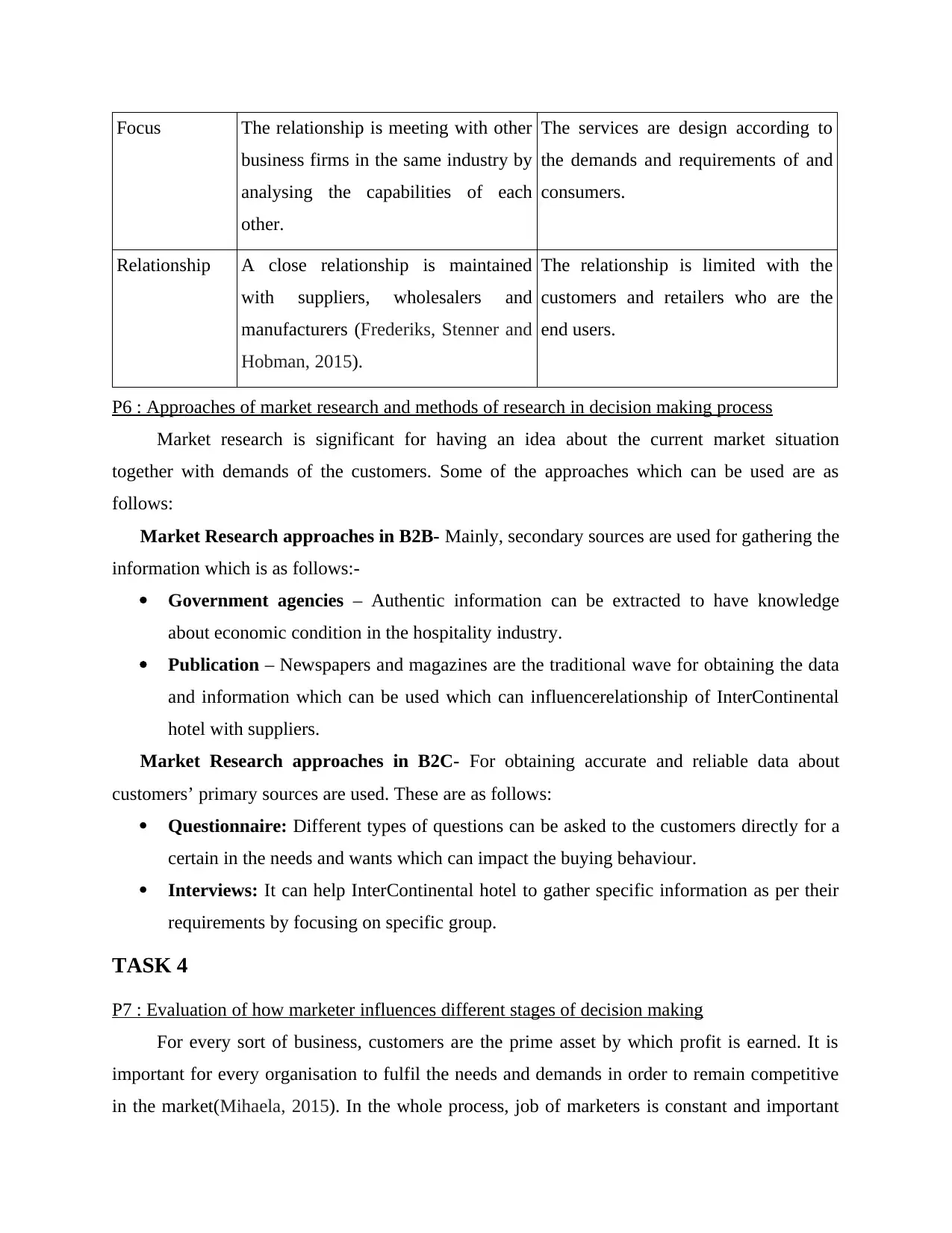
Focus The relationship is meeting with other
business firms in the same industry by
analysing the capabilities of each
other.
The services are design according to
the demands and requirements of and
consumers.
Relationship A close relationship is maintained
with suppliers, wholesalers and
manufacturers (Frederiks, Stenner and
Hobman, 2015).
The relationship is limited with the
customers and retailers who are the
end users.
P6 : Approaches of market research and methods of research in decision making process
Market research is significant for having an idea about the current market situation
together with demands of the customers. Some of the approaches which can be used are as
follows:
Market Research approaches in B2B- Mainly, secondary sources are used for gathering the
information which is as follows:-
Government agencies – Authentic information can be extracted to have knowledge
about economic condition in the hospitality industry.
Publication – Newspapers and magazines are the traditional wave for obtaining the data
and information which can be used which can influencerelationship of InterContinental
hotel with suppliers.
Market Research approaches in B2C- For obtaining accurate and reliable data about
customers’ primary sources are used. These are as follows:
Questionnaire: Different types of questions can be asked to the customers directly for a
certain in the needs and wants which can impact the buying behaviour.
Interviews: It can help InterContinental hotel to gather specific information as per their
requirements by focusing on specific group.
TASK 4
P7 : Evaluation of how marketer influences different stages of decision making
For every sort of business, customers are the prime asset by which profit is earned. It is
important for every organisation to fulfil the needs and demands in order to remain competitive
in the market(Mihaela, 2015). In the whole process, job of marketers is constant and important
business firms in the same industry by
analysing the capabilities of each
other.
The services are design according to
the demands and requirements of and
consumers.
Relationship A close relationship is maintained
with suppliers, wholesalers and
manufacturers (Frederiks, Stenner and
Hobman, 2015).
The relationship is limited with the
customers and retailers who are the
end users.
P6 : Approaches of market research and methods of research in decision making process
Market research is significant for having an idea about the current market situation
together with demands of the customers. Some of the approaches which can be used are as
follows:
Market Research approaches in B2B- Mainly, secondary sources are used for gathering the
information which is as follows:-
Government agencies – Authentic information can be extracted to have knowledge
about economic condition in the hospitality industry.
Publication – Newspapers and magazines are the traditional wave for obtaining the data
and information which can be used which can influencerelationship of InterContinental
hotel with suppliers.
Market Research approaches in B2C- For obtaining accurate and reliable data about
customers’ primary sources are used. These are as follows:
Questionnaire: Different types of questions can be asked to the customers directly for a
certain in the needs and wants which can impact the buying behaviour.
Interviews: It can help InterContinental hotel to gather specific information as per their
requirements by focusing on specific group.
TASK 4
P7 : Evaluation of how marketer influences different stages of decision making
For every sort of business, customers are the prime asset by which profit is earned. It is
important for every organisation to fulfil the needs and demands in order to remain competitive
in the market(Mihaela, 2015). In the whole process, job of marketers is constant and important
Paraphrase This Document
Need a fresh take? Get an instant paraphrase of this document with our AI Paraphraser
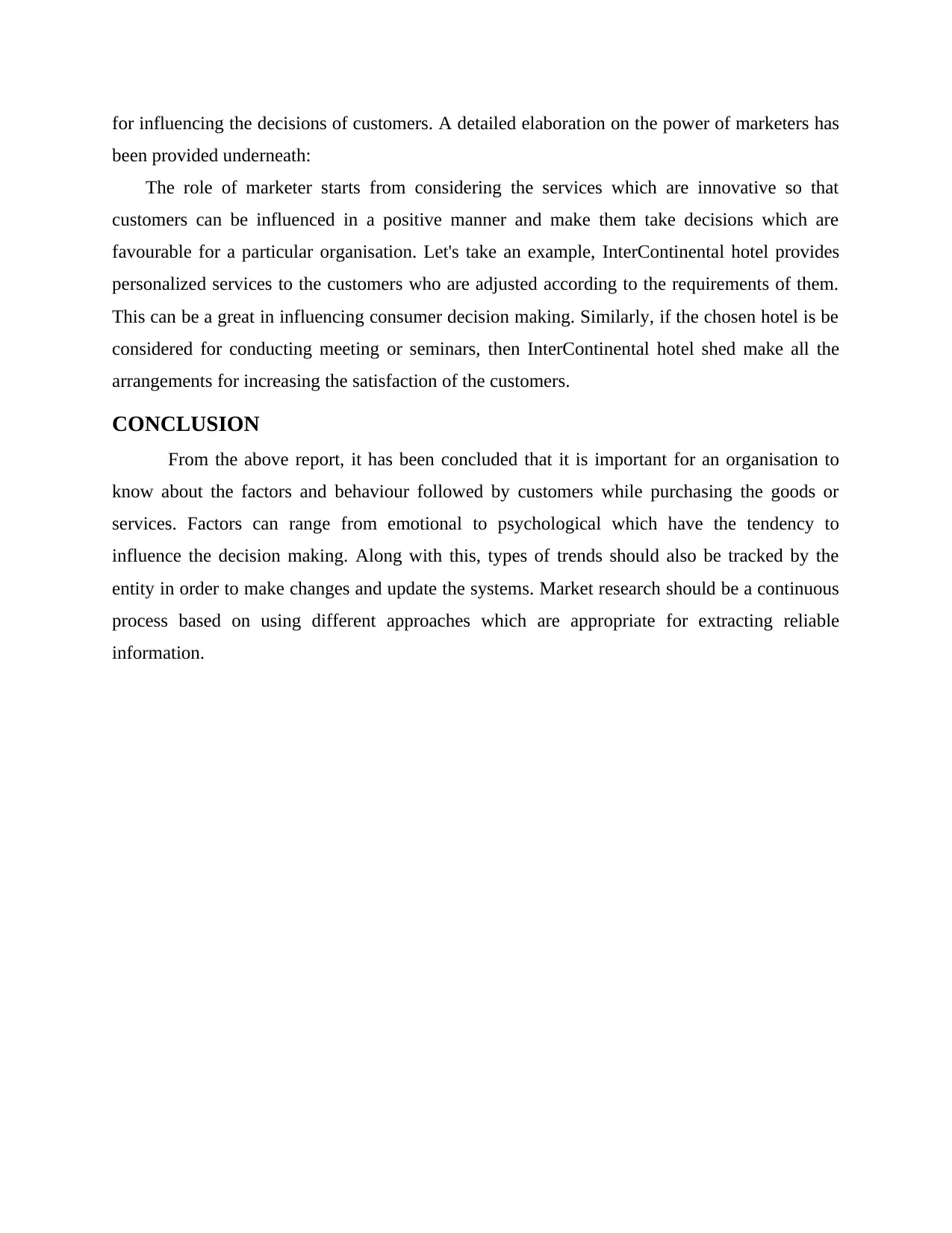
for influencing the decisions of customers. A detailed elaboration on the power of marketers has
been provided underneath:
The role of marketer starts from considering the services which are innovative so that
customers can be influenced in a positive manner and make them take decisions which are
favourable for a particular organisation. Let's take an example, InterContinental hotel provides
personalized services to the customers who are adjusted according to the requirements of them.
This can be a great in influencing consumer decision making. Similarly, if the chosen hotel is be
considered for conducting meeting or seminars, then InterContinental hotel shed make all the
arrangements for increasing the satisfaction of the customers.
CONCLUSION
From the above report, it has been concluded that it is important for an organisation to
know about the factors and behaviour followed by customers while purchasing the goods or
services. Factors can range from emotional to psychological which have the tendency to
influence the decision making. Along with this, types of trends should also be tracked by the
entity in order to make changes and update the systems. Market research should be a continuous
process based on using different approaches which are appropriate for extracting reliable
information.
been provided underneath:
The role of marketer starts from considering the services which are innovative so that
customers can be influenced in a positive manner and make them take decisions which are
favourable for a particular organisation. Let's take an example, InterContinental hotel provides
personalized services to the customers who are adjusted according to the requirements of them.
This can be a great in influencing consumer decision making. Similarly, if the chosen hotel is be
considered for conducting meeting or seminars, then InterContinental hotel shed make all the
arrangements for increasing the satisfaction of the customers.
CONCLUSION
From the above report, it has been concluded that it is important for an organisation to
know about the factors and behaviour followed by customers while purchasing the goods or
services. Factors can range from emotional to psychological which have the tendency to
influence the decision making. Along with this, types of trends should also be tracked by the
entity in order to make changes and update the systems. Market research should be a continuous
process based on using different approaches which are appropriate for extracting reliable
information.
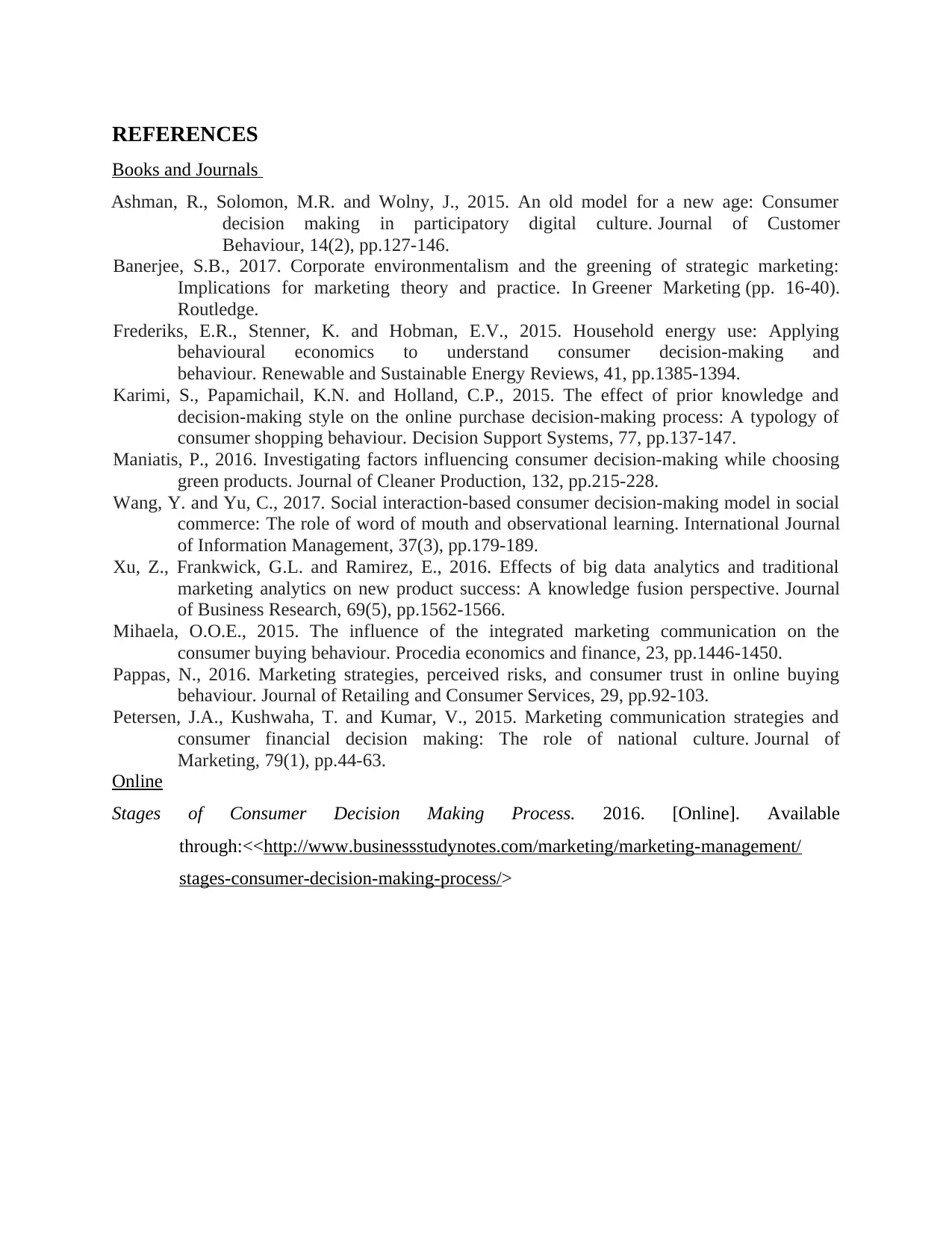
REFERENCES
Books and Journals
Ashman, R., Solomon, M.R. and Wolny, J., 2015. An old model for a new age: Consumer
decision making in participatory digital culture. Journal of Customer
Behaviour, 14(2), pp.127-146.
Banerjee, S.B., 2017. Corporate environmentalism and the greening of strategic marketing:
Implications for marketing theory and practice. In Greener Marketing (pp. 16-40).
Routledge.
Frederiks, E.R., Stenner, K. and Hobman, E.V., 2015. Household energy use: Applying
behavioural economics to understand consumer decision-making and
behaviour. Renewable and Sustainable Energy Reviews, 41, pp.1385-1394.
Karimi, S., Papamichail, K.N. and Holland, C.P., 2015. The effect of prior knowledge and
decision-making style on the online purchase decision-making process: A typology of
consumer shopping behaviour. Decision Support Systems, 77, pp.137-147.
Maniatis, P., 2016. Investigating factors influencing consumer decision-making while choosing
green products. Journal of Cleaner Production, 132, pp.215-228.
Wang, Y. and Yu, C., 2017. Social interaction-based consumer decision-making model in social
commerce: The role of word of mouth and observational learning. International Journal
of Information Management, 37(3), pp.179-189.
Xu, Z., Frankwick, G.L. and Ramirez, E., 2016. Effects of big data analytics and traditional
marketing analytics on new product success: A knowledge fusion perspective. Journal
of Business Research, 69(5), pp.1562-1566.
Mihaela, O.O.E., 2015. The influence of the integrated marketing communication on the
consumer buying behaviour. Procedia economics and finance, 23, pp.1446-1450.
Pappas, N., 2016. Marketing strategies, perceived risks, and consumer trust in online buying
behaviour. Journal of Retailing and Consumer Services, 29, pp.92-103.
Petersen, J.A., Kushwaha, T. and Kumar, V., 2015. Marketing communication strategies and
consumer financial decision making: The role of national culture. Journal of
Marketing, 79(1), pp.44-63.
Online
Stages of Consumer Decision Making Process. 2016. [Online]. Available
through:<<http://www.businessstudynotes.com/marketing/marketing-management/
stages-consumer-decision-making-process/>
Books and Journals
Ashman, R., Solomon, M.R. and Wolny, J., 2015. An old model for a new age: Consumer
decision making in participatory digital culture. Journal of Customer
Behaviour, 14(2), pp.127-146.
Banerjee, S.B., 2017. Corporate environmentalism and the greening of strategic marketing:
Implications for marketing theory and practice. In Greener Marketing (pp. 16-40).
Routledge.
Frederiks, E.R., Stenner, K. and Hobman, E.V., 2015. Household energy use: Applying
behavioural economics to understand consumer decision-making and
behaviour. Renewable and Sustainable Energy Reviews, 41, pp.1385-1394.
Karimi, S., Papamichail, K.N. and Holland, C.P., 2015. The effect of prior knowledge and
decision-making style on the online purchase decision-making process: A typology of
consumer shopping behaviour. Decision Support Systems, 77, pp.137-147.
Maniatis, P., 2016. Investigating factors influencing consumer decision-making while choosing
green products. Journal of Cleaner Production, 132, pp.215-228.
Wang, Y. and Yu, C., 2017. Social interaction-based consumer decision-making model in social
commerce: The role of word of mouth and observational learning. International Journal
of Information Management, 37(3), pp.179-189.
Xu, Z., Frankwick, G.L. and Ramirez, E., 2016. Effects of big data analytics and traditional
marketing analytics on new product success: A knowledge fusion perspective. Journal
of Business Research, 69(5), pp.1562-1566.
Mihaela, O.O.E., 2015. The influence of the integrated marketing communication on the
consumer buying behaviour. Procedia economics and finance, 23, pp.1446-1450.
Pappas, N., 2016. Marketing strategies, perceived risks, and consumer trust in online buying
behaviour. Journal of Retailing and Consumer Services, 29, pp.92-103.
Petersen, J.A., Kushwaha, T. and Kumar, V., 2015. Marketing communication strategies and
consumer financial decision making: The role of national culture. Journal of
Marketing, 79(1), pp.44-63.
Online
Stages of Consumer Decision Making Process. 2016. [Online]. Available
through:<<http://www.businessstudynotes.com/marketing/marketing-management/
stages-consumer-decision-making-process/>

Secure Best Marks with AI Grader
Need help grading? Try our AI Grader for instant feedback on your assignments.

1
1 out of 11
Related Documents
Your All-in-One AI-Powered Toolkit for Academic Success.
+13062052269
info@desklib.com
Available 24*7 on WhatsApp / Email
![[object Object]](/_next/static/media/star-bottom.7253800d.svg)
Unlock your academic potential
© 2024 | Zucol Services PVT LTD | All rights reserved.





